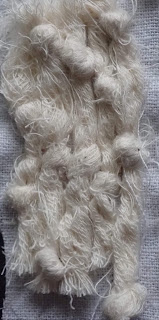7 a and 7b: these first two samples were done using the same technique. As I had problems with the shirring elastic technique in the previous chapter, I used a wider elastic on the back of the fabric which I pulled while stitching causing the fabric to pucker. In sample 7a I used a coton fabric, the irregular creases in the fabric are very close and the sample feels a bit "stiff". In sample 7b a light silk fabric was used, the creases are softer and so is the general feel of the sample.
7c and 7d: The same technique was used for these two samples. For 7d the spiralling stitching was done on a silk velvet, whereas for 7 d a coton mule was used. Of course the bumps of 7c feel softer, while this technique caused spikes in the somewhat stiffer fabric. The creases are finer in 7d.
7e: this sample is not related to a companion sample. I used this method already in paper. Here the irregular shapes were cut out with the heat tool in a polyester sheer fabric and then stitched in couples of two tied with a little knot . The surface created here is very "light and feathery" to the touch.
It might be an idea to space the shapes and tie them off with a really chunky thread to create further texture
7f: the shapes and the textures created here are very defined and firmed. However, the seed stitches between the "pebbles" adds a second, different feel to this sample
7g: here strips of a sheer polyested fabric were knotted and then applied to a coton background. the strips were then cut back to practically only leave the knots. The texture created here feels a little "bumpy", because of the stiff quality of the fabric however, the end of the strips add a second dimension to the feel
7h: knotted coton scrim strips were applied to a coton background with stitches that are barely visible (it would be an idea to use a thicker thread to add more texture). The surface feels soft because of the fabric used, but also firm because of the knots
7i: here pin tucks were stitched with a twin needle and a coton thread inserted in the tunnel. Because of the narrow spacing of the tucks, the surface feels "geometric and regular"
7j: a more organic sample because of the fabric used.Pipe cleaners were wrapped and applied to a background fabric. The surface feels soft and regular
7k: little wooden sticks were inserted in the pleats, then wrapped with stitching. Further stitching was added into the "valleys". In comparison to the previous sample, this one feels very hard and the texture is more defined.
7l: for this sample the surface was first crocheted with a merion yarn before being felted with the embellisher to a sheer fabric, the further wet felted. The surface created here is soft because of the quality of the wool, with very defined bumps and valleys.
It could be interesting to do more stitching into the little "holes"
Pleated fabric: samples 7m, 7n, 7o, 7r
7m: hand pleated on a sheer polyester (curtain) fabric. The hills and valleys created here are irregular, in general the fabric feels soft to the touch
7n: done on the pleater, this sample presents crisps and regular pleats and so does the general feel of it
7o: you can hardly recognize the pleats on this fabric (silk velvet). The valleys are very "deep", the general feel is of course a very soft one.
7r: another felt sample done with prefelt. The pleats were created with the embellisher. The surface created is soft and firm.
7p: one of my favourites: holes were cut in a regular grid into acrylic felt. The strips of coton scrim were pulled through these holes to create loops which were then wrapped. This created a very textural and soft sample
7q: here strips of acrylic velvet were pleated then applied to a background changing the direction of the pleats. The feel of the texture is not very distinct. I might try to apply paint to the edges to make them stiffer.
7s: one last felted sample: the prefelt was felted together with the embellisher the joined to form rombus which were then "filled" with coton scrim, also felted to fix them to the felt background. This is a very high relief sample with soft yet defined edges and with a softer feel (coton scrim)
This last sample wasn't done for this module. However I think it fits perfectly well into it. It was inspired by the pattern created by the sun in the swimming pool at the place where we spent our last holidays in September.
The fabric used here is a stiffer one with natural "flowing movement" which I emphasized with stitching, Then white acrylic paint was added to it.
Flying Free
2 months ago





















1 comment:
What wonderfully inventive textural samples Pascale! I like the idea of working the same technique with two contrasting fabrics and getting such different results. I am on the same chapter and you have inspired me to try some more unusual ideas, thanks.
Post a Comment